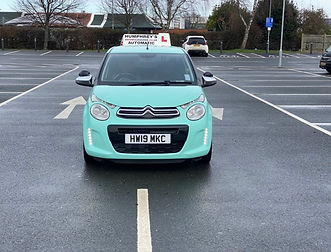Humphrey's
Driving Lessons

Driving Test Reverse Bay Parking Exercise
The Video Is after this description
The bay park exercise, often a component of the practical driving test in the UK, assesses your ability to safely and accurately manoeuvre your vehicle into a parking bay. There are two main variations you might be asked to perform:
-
Reverse Bay Park: Reversing into a bay.
-
Forward Bay Park: Driving forwards into a bay.
Here's a breakdown of how to generally complete each, focusing on the key elements the examiner will be looking for:
General Principles for Both Exercises:
-
Observations: Throughout the entire manoeuvre, constant and effective all-round observations (using mirrors and looking over your shoulders) are crucial. You must be aware of other vehicles, pedestrians, and any obstacles.
-
Control: Maintain slow, controlled speed using clutch control (manual) or gentle accelerator/brake (automatic).
-
Accuracy: Aim to park neatly within the lines of the bay.
-
Safety: Prioritise safety at all times. If another vehicle approaches, be prepared to stop and give way.
-
Planning: Look well ahead and plan your movements.
1. Reverse Bay Park
This is the more common of the two and often considered more challenging. The examiner will typically ask you to reverse into a bay on the left or right.
Steps:
-
Select Your Bay: The examiner will either direct you to a specific bay or ask you to choose one. Look for a bay that gives you sufficient space to manoeuvre, ideally with clear lines.
-
Approach and Positioning:
-
Pass the Bay: Drive past the target bay slowly.
-
Reference Point: Position your car so that the front of your car is approximately two bay widths past the target bay (this is a common guide, but varies slightly depending on your car). The goal is to create enough space for your car to swing into the bay.
-
Distance from Bays: Aim to be about a car's width away from the parked cars or empty bays to your left (if reversing into a bay on your left).
-
-
Initial Reverse and Steering:
-
Select Reverse Gear: Engage reverse gear.
-
All-Round Observations: Check all mirrors and over both shoulders for any hazards.
-
Straight Backwards: Begin reversing slowly in a straight line, continuing observations.
-
Steering Point (Full Lock): When the chosen reference point (e.g., a specific part of your car lining up with a particular bay line), start turning the steering wheel full lock towards the bay you intend to enter (e.g., full left lock for a bay on your left).
-
-
Monitoring Progress and Straightening Up:
-
Watch Mirrors: Continuously check your left and right mirrors. You should see your car gradually swinging into the bay.
-
Straighten When Parallel: As your car becomes parallel with the lines of the bay, rapidly straighten your steering wheel (usually 1.5 turns back from full lock for most cars).
-
Adjust if Necessary: If you are too close to one side, you can make small adjustments with your steering while continuing to reverse.
-
-
Final Positioning:
-
Reverse Slowly: Continue reversing slowly and straight back until you are neatly within the bay.
-
Stop Safely: Stop before hitting any curb or obstruction at the back of the bay.
-
Handbrake and Neutral: Apply the handbrake and select neutral gear.
-
Common Faults to Avoid (Reverse Bay Park):
-
Poor or lack of observations.
-
Hitting the curb or lines.
-
Parking significantly off-centre.
-
Excessive shunting (multiple forward/back movements). One small forward adjustment is usually acceptable if needed.
2. Forward Bay Park
This is generally considered easier than the reverse bay park, as it's often more intuitive. The examiner might ask you to drive forwards into a bay.
Steps:
-
Select Your Bay: As with reverse, choose or be directed to a suitable bay.
-
Approach and Positioning:
-
Wide Approach: Aim for a wide approach to give yourself the best turning circle. If the bay is on your left, keep to the right side of the aisle. If on your right, keep to the left.
-
Distance from Bays: Ensure you leave enough space for the front of your car to clear any parked vehicles or obstacles as you turn.
-
Steering Point: As the front of your car aligns with the first line of the bay you want to enter, or slightly before, begin to turn your steering wheel towards the bay. The exact point will depend on your car's turning circle and the width of the aisle.
-
-
Steering and Monitoring:
-
Full Lock (if needed): You may need to apply full lock quite early to get the car to swing sufficiently into the bay.
-
Watch Mirrors: Use your mirrors (particularly side mirrors) to monitor your position in relation to the bay lines and any other vehicles.
-
Straighten Up: As the car becomes parallel with the bay lines, straighten your steering wheel.
-
-
Final Positioning:
-
Drive Slowly: Continue driving slowly and straight forwards into the bay.
-
Stop Safely: Stop when you are neatly within the bay, ensuring the front of your car isn't protruding excessively.
-
Handbrake and Neutral/Park: Apply the handbrake and select neutral (manual) or park (automatic).
-
Common Faults to Avoid (Forward Bay Park):
-
Not taking a wide enough approach, leading to cutting the corner.
-
Parking significantly off-centre.
-
Hitting the curb or lines.
-
Insufficient observations, especially when turning into the bay.
.
Starting position

Line up with bay
